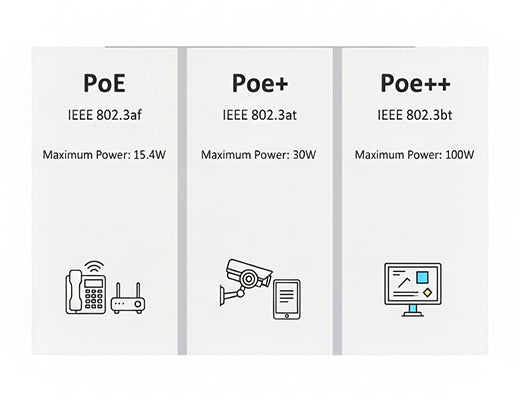
What is PoE? A Beginner's Guide to Power over Ethernet
|
|
Time to read 4 min
|
|
Time to read 4 min
This beginner's guide answers the fundamental question: What is PoE? PoE (Power over Ethernet) is a game-changing network technology that allows a single standard Ethernet cable to transmit both data and electrical power to compatible devices. This eliminates the need for separate power cables and outlets, dramatically simplifying installations for devices like IP cameras, Wi-Fi access points, and VoIP phones. We'll explain how it works, the different standards, and how you can leverage it in your own projects.
PoE sends low-voltage power and data over the same Ethernet cable, removing the need for a separate power supply at the device location.
The three primary benefits of PoE are significant cost savings (fewer cables, no electrician), faster installation, and unmatched flexibility in device placement.
There are different standards like PoE (802.3af), PoE+ (802.3at), and PoE++ (802.3bt), which deliver increasing amounts of power for different types of devices.
The device that provides power is called a PSE (e.g., a PoE router or switch), and the device that receives power is called a PD (e.g., an IP camera).
I was on a site visit with an installer who was setting up a new security system. He had just finished mounting an IP camera in the perfect spot on the ceiling of a large warehouse. He'd run the Ethernet cable for data all the way back to the server rack. Then he sighed. "Now for the hard part," he said, "I have to figure out how to get a power outlet up here."
What if I told you the hard part was already done? What if that single Ethernet cable he just ran could do both jobs?
Let's be clear: it can. The technology that makes this possible is called Power over Ethernet (PoE), and once you understand it, you'll wonder how you ever lived without it.

Every PoE connection involves two types of devices:
The real 'aha!' moment for many is realizing how safe PoE is. You can't accidentally "fry" your laptop by plugging it into a PoE port. Before a PSE sends any significant power, it performs an intelligent "handshake" with the connected device to verify two things:
Only after this successful handshake will the PSE deliver the appropriate amount of power. If it detects a non-PoE device, it will only send data.
As devices have become more power-hungry, the PoE standard has evolved. It's crucial to know the difference.
Standard |
IEEE Name |
Max Power at PSE |
Common Devices |
PoE |
802.3af |
15.4W |
VoIP Phones, basic security cameras |
PoE+ |
802.3at |
30W |
Pan-Tilt-Zoom (PTZ) cameras, Wi-Fi 6 APs |
PoE++ |
802.3bt |
60W / 100W |
High-power cameras, thin clients |
A professional device like the Robustel R2120 supports both PoE and PoE+ (802.3af/at), ensuring compatibility with a wide range of modern devices.

So, What is PoE? It's a foundational technology that offers undeniable benefits in cost, time, and flexibility for anyone deploying network-connected devices. By understanding the basics of how it works and the different standards available, you can make smarter decisions about your network infrastructure. And by leveraging an all-in-one industrial PoE router, you can take those benefits to the next level, creating solutions that are not only simple to install but also incredibly reliable and manageable.
Learn more in our main guide:

A1: No, it is perfectly safe. A PoE sourcing device (PSE) like a switch or router performs a special "handshake" before sending power. If it detects that the connected device (like your laptop) is not PoE-compatible, it will only send data and will not send any electrical power.
A2: The PoE standard is designed to work over a standard Ethernet cable run of up to 100 meters (328 feet). If you need to go further, you can use a PoE extender.
A3: For standard PoE (802.3af) and PoE+ (802.3at), a standard quality Cat5e or Cat6 Ethernet cable is sufficient. For the highest power PoE++ standards, a Cat6A or better cable is recommended to handle the power and minimize heat.